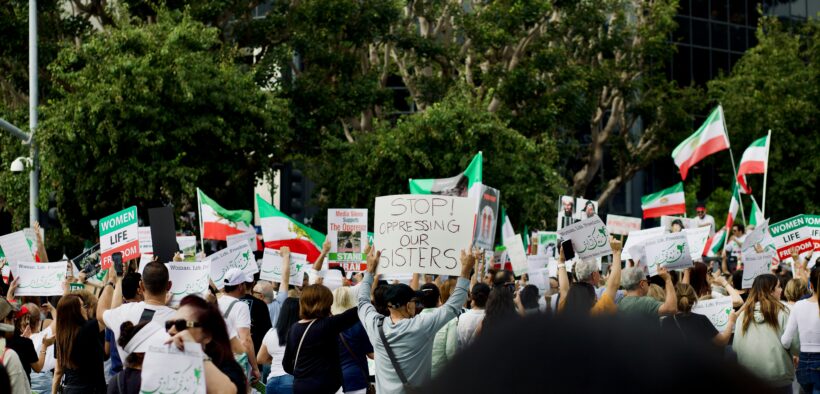Resilient Voices: Evaluating The Islamic Republic of Iran’s Women’s Rights Laws by International Standards
Share

Image Credits: @craigmelville on Unsplash (Unsplash License)
Introduction: The History of Women’s Rights since the Iranian Revolution
Since the year 1979, when the Iranian Revolution took place, women in the country have been burdened with draconian laws and norms. The theocratic foundation, named the Islamic Republic, enforced significant changes to the country that aligned with what many scholars believe are exaggerated and not completely accurate Islamic Shia ideologies. One of the most significant social changes that came with the revolution was the social reforms that targeted women. Women under the Islamic regime had to, and still have to, follow a strict dress code that can mean life or death. In an interview with Woodrow Wilson Center’s radio program and Haleh Esfandiari, she called the women of Iran “the first sacrificial lambs of the pre-revolutionary movement”. Today, censorship and barbarousness continue to produce a dark shadow in the everyday lives of the Iranian people. The death of Masah Amini, a young Kurdish woman who was killed violently by the Islamic Republic’s police force for not wearing her hijab correctly, drew international attention to the human rights laws that Iran violates. The devastating treatment by the regime gave birth to a global community that held powerful demonstrations in defiance of the oppressive regime. Protesters showed unity to the women of Iran who could not speak up for themselves without the fear of getting hurt or imprisoned. The demonstrations saw women ripping off their hijabs, cutting their hair, intoning phrases used against the regime, singing beautiful songs of artists unlawfully detained, and using social media to circulate coverage as fast as possible. The name and the story of Masah Amini continue to shine a legacy today as Iranian women, powerful countries around the world, and changing legislation tries to ensure the unfathomable violence against women by the Islamic Republic of Iran does not continue.
The Expulsion of Iran From the UN Women’s Commission
1946 gave birth to the UN Commission on the Status of Women, a sector of the UN that’s main priority is safety, human rights, and equality for women. The commission has devised numerous conferences and international laws undermining any forces against women. As one of the most potent and intergovernmental forces for women, membership in the commission is limited and is now limited to Iran because of its women’s rights violations. To remove a country from the commission, which is likely only if mass atrocities have been committed by the governing body, a vote must take place, which in this case was recommended by the United States. Out of over fifty member states, twenty-nine states voted for Iran’s expulsion, reflecting international concern about Iran’s violation of essential rights, such as the freedom to speak freely, fair trial, and freedom of assembly.
Government’s Violation of International Women’s Rights Treaties
Along with fundamental human rights, Iran infringes on international treaties and laws that are abided by many countries around the world for the safety of women. One of the most well-known treaties is the Convention on the Elimination of all Forms of Discrimination against Women, which orders that “governments have a legal obligation to protect women from violence, to promote the human rights of all women and to ensure their economic, legal, social and political empowerment.” After diligently researching each one of the 30 articles in CEDAW, which is known as the Bill of Rights for Women, Iran breaks almost every single article that ensures the protection and freedoms of women. Article 2 states countries should make legislation and laws that “establish legal protection of the rights of women on an equal basis with men,” “refrain from engaging in any act or practice of discrimination,” and “repeal all national penal provisions which constitute discrimination against women.” While at first glance, one may realize automatically that Iran does not treat women at the same standards as other countries, Article 20 of the Islamic Republic of Iran’s constitution says otherwise. Article 20 states, “All citizens of the country, both men and women, equally enjoy the protection of the law and enjoy all human, political, economic, social, and cultural rights, in conformity with Islamic criteria.” At a superficial level, Iran seems cooperative with international regulations and the objectives placed in treaties such as CEDAW; however, there is an evident contrast and invisibility to the actual implementation of the constitution in Iran. This duality discloses the grave situation that the Iranian women find themselves in, as well as the precarious situation Iran’s government finds themselves in as they get driven out of influential international decision-making treaties.
Torture
While there are broad human rights issues with Iran’s government, there are also more specific and nuanced concerns, such as the use of torture that violates international treaties and laws. The UN Convention against Torture and Other Cruel, Inhuman or Degrading Treatment or Punishment serves as a commission that “requires State parties to criminalize torture under its national laws,” investigate any allegations of torture, increase awareness and education of the banning of torture, and provide a clear explanation of what torture entails and can be defined as. During the Mahsa Amini wave of protests, media attention was mainly on the torture that the Islamic Republic caused the Iranian people and even the young children. According to Amnesty International, Iranian authorities a few months ago admitted that 22,000 protestors, including children, were subjected to torture in numerous ways, such as sexual violence, and forced to give untruthful confessions. These acts of torture showcase a breach of international human rights and illustrate the government’s complete refusal of basic human rights for women in Iran.
Suppression of Peaceful Assembly
Finally, the last aspect of human rights that the Iranian government contravenes is in the International Covenant on Civil and Political Rights (ICCPR) and is showcased through their reaction to the protests for women’s rights. This committee serves to remind people globally about their rights in civil pursuits, such as the right to peaceful assembly. The UN states that the right to peaceful assembly is a liberty every person should have, “the right of peaceful assembly includes the right to hold meetings, sit-ins, strikes, rallies, events or protests, offline and online. It serves as a vehicle for exercising many other rights guaranteed under international law, with which it is linked intrinsically and forms the basis for participating in peaceful protests.” However, Iran’s response to peaceful protest showcases a separation and division from the precise definition of the ICCPR, especially when it comes to women’s protests. In 2022, the Mahsa Amini protest marked a significant mobilization of women fighting for their rights. These demonstrations prompted a violent response from the Iranian government in an effort to showcase the standing and strength of the theocratic government. As the government lost hold of being able to enforce the religious requirements, its legitimacy and power in the eyes of Iranians plummeted. Therefore, the decline in authority is why the crackdown specifically for the Women Life Freedom protests was so aggressive and violent. This highlights the myriad of times that the government breached international standards and treaties. Additionally, it also showcases their infringement on Iranian rights and, more specifically, on women’s rights.
Conclusion: Ongoing Fight for Women’s Rights in Iran
In conclusion, the fight against injustices done by the Islamic Republic of Iran since the revolution represents a distressing illustration of the persecution and subjugation to which Iranian women have fallen victim. As the world continues to fight for the fundamental rights of women in Iran and make the global sphere more aware of the international law and treaties that Iran breaks, it becomes clear that if the country continues to not adhere to the rule of law then there must be bigger action taken. Their actions, which starkly contrast the law and global treaties, showcase the urgency of ensuring that Iran’s actions towards Iranian women start meeting international rule of law and standards. The story, not without hardships, continues to move forward and hopefully toward a future of justice for all the resilient Iranian women.
Woman, Life, Freedom
Zan-Zendegi-Azadi زن زندگی آزادی


Want to get involved?
Connect with us! Connect with us!